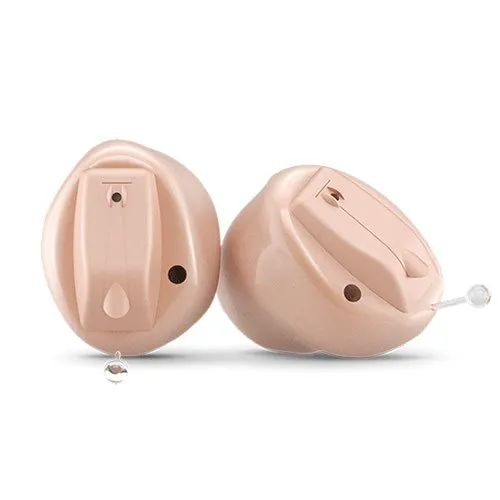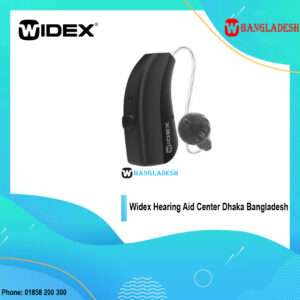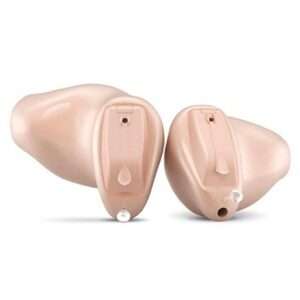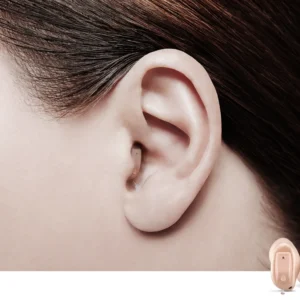What is the Widex In-the-canal (ITC) hearing aid ?
The Widex In-the-canal (ITC) hearing aid is a type of hearing aid that is custom-fit to sit inside the ear canal, making it less visible than larger behind-the-ear (BTE) models. The ITC hearing aid is designed to provide amplification and improve hearing in individuals with mild to moderate hearing loss.
The ITC hearing aid is created by taking an impression of the user’s ear canal, which is used to create a custom-fitted shell that sits comfortably in the ear canal. The device is designed to be discreet and can be removed easily. It typically includes features such as volume control, noise reduction, and feedback cancellation to provide a clear and natural sound experience for the user.
However, it’s important to note that the effectiveness of a hearing aid will depend on a variety of factors, including the severity and type of hearing loss, the individual’s lifestyle and preferences, and the quality and fit of the hearing aid. It’s always best to consult with an audiologist or hearing care professional to determine the most appropriate type of hearing aid for your specific needs.
How Does Widex In-the-canal (ITC) Hearing Aid Work?
The Widex In-the-canal (ITC) hearing aid works by using a microphone to pick up sound waves from the environment. The sound waves are then converted into electrical signals that are processed by the hearing aid’s digital signal processor (DSP).
The DSP analyzes the signals and applies amplification and other processing to enhance the sound quality and make it easier for the user to hear. The amplified signals are then sent to a miniature speaker or receiver, which converts the electrical signals back into sound waves that are delivered into the ear canal.
The ITC hearing aid is custom-fitted to the user’s ear canal, which helps to reduce feedback and improve sound quality. The device is typically small and discreet, and it can be programmed to the user’s specific hearing needs, preferences, and listening environments.
Overall, the Widex In-the-canal (ITC) hearing aid is designed to help individuals with mild to moderate hearing loss hear more clearly and comfortably in a variety of listening situations, including noisy environments and conversations with multiple speakers.
How do I Know if I am a Good Candidate for Widex ITC Hearing Aids?
Determining whether you are a good candidate for the Widex In-the-canal (ITC) hearing aid depends on several factors. The ITC hearing aid is typically recommended for individuals with mild to moderate hearing loss who want a discreet hearing aid that sits inside the ear canal. Here are some factors that may indicate you are a good candidate for the Widex ITC hearing aid:
- Mild to moderate hearing loss: The ITC hearing aid is best suited for individuals with mild to moderate hearing loss. If you have severe or profound hearing loss, you may need a more powerful hearing aid.
- Ear anatomy: The ITC hearing aid requires a certain amount of space in the ear canal to fit properly. If you have very small ear canals or a lot of earwax buildup, an ITC hearing aid may not be suitable.
- Lifestyle: The ITC hearing aid is designed for individuals who lead an active lifestyle and want a discreet hearing aid that is easy to use and maintain. If you work in a noisy environment or engage in water activities, such as swimming or water sports, an ITC hearing aid may not be the best choice.
- Personal preference: The ITC hearing aid is a great option for individuals who want a discreet hearing aid that is almost invisible to others. If you prefer a more visible hearing aid, such as a behind-the-ear (BTE) hearing aid, then the ITC hearing aid may not be the best choice.
It’s important to consult with an audiologist or hearing care professional to determine whether the Widex ITC hearing aid is the best option for your specific needs and preferences. A hearing evaluation and consultation with a professional will help determine the best hearing aid for your lifestyle and hearing loss.
What are the advantages of Widex ITC hearing aids compared to other types of hearing aids?
Widex In-the-canal (ITC) hearing aids offer several advantages compared to other types of hearing aids, including:
- Discreetness: ITC hearing aids are custom-fitted to the ear canal and sit deep inside the ear, making them almost invisible. This makes them a popular choice for people who want a hearing aid that is discreet and doesn’t draw attention.
- Comfort: ITC hearing aids are designed to fit comfortably inside the ear canal, which can make them more comfortable to wear for extended periods of time.
- Sound quality: ITC hearing aids are designed to deliver natural and clear sound quality. Because they are custom-fitted to the ear canal, they can help reduce feedback and other types of distortion that can affect the sound quality.
- Directionality: Many ITC hearing aids feature advanced directional microphones that can help pick up speech sounds while reducing background noise. This can be especially beneficial in noisy environments, such as restaurants or public spaces.
- Easy to use: ITC hearing aids are typically easy to use and maintain. They may include features such as volume control and program options that can be adjusted using a remote control or a smartphone app.
- Active lifestyle: Because ITC hearing aids are small and discreet, they are a good choice for people with an active lifestyle. They are less likely to fall off during physical activity or get in the way of helmets or other types of headgear.
It’s important to note that the effectiveness of a hearing aid will depend on a variety of factors, including the severity and type of hearing loss, the individual’s lifestyle and preferences, and the quality and fit of the hearing aid. It’s always best to consult with an audiologist or hearing care professional to determine the most appropriate type of hearing aid for your specific needs.
Can I use Widex ITC Hearing Aids if I Have Severe Hearing Loss?
Widex In-the-canal (ITC) hearing aids are generally designed for individuals with mild to moderate hearing loss. They may not be the best option for people with severe hearing loss as they may not provide enough amplification to improve speech clarity and understanding.
However, some ITC hearing aids may be suitable for individuals with severe hearing loss if they have powerful enough amplification and advanced signal processing technology to help enhance speech clarity and reduce background noise. In these cases, an ITC hearing aid may be recommended by an audiologist or hearing care professional after a thorough hearing evaluation and consultation.
It’s important to note that people with severe hearing loss may benefit from other types of hearing aids, such as behind-the-ear (BTE) or receiver-in-canal (RIC) hearing aids, which may provide more amplification and features to improve speech understanding. A hearing care professional can help you determine the most appropriate hearing aid for your specific hearing loss and lifestyle.
How comfortable are Widex ITC hearing aids to wear, and are they visible to others?
Widex In-the-canal (ITC) hearing aids are designed to be comfortable to wear for extended periods of time. Because they are custom-fitted to the ear canal, they provide a secure and snug fit that helps to reduce irritation and discomfort. However, as with any hearing aid, it may take some time to adjust to wearing ITC hearing aids if you are not used to wearing anything in your ear.
One of the key advantages of ITC hearing aids is their discreetness. They sit deep inside the ear canal and are custom-fitted to the shape of the ear, making them almost invisible to others. This makes them a popular choice for people who want a hearing aid that is discreet and doesn’t draw attention.
However, it’s important to note that the visibility of an ITC hearing aid may depend on factors such as the size and shape of your ear canal, as well as the color and design of the hearing aid. Some people may prefer a more visible hearing aid, such as a behind-the-ear (BTE) or receiver-in-canal (RIC) hearing aid, which may offer more features and power to improve hearing. Ultimately, the choice of hearing aid will depend on your specific hearing loss, lifestyle, and personal preferences, and should be determined in consultation with a hearing care professional.
How do I clean and maintain my Widex ITC hearing aids?
Proper cleaning and maintenance of your Widex In-the-canal (ITC) hearing aids is essential to ensure optimal performance and longevity. Here are some tips for cleaning and maintaining your ITC hearing aids:
- Clean your hearing aids daily: Use a soft, dry cloth or a specialized hearing aid cleaning brush to gently clean your hearing aids. Avoid using water or cleaning solutions, as this can damage the hearing aid.
- Keep your ears clean: Ensure that your ears are clean and free of excess wax, as this can block the sound from reaching the hearing aid. If you have excessive earwax, speak to your audiologist or hearing care professional for advice on how to safely remove it.
- Avoid moisture: ITC hearing aids are vulnerable to moisture, which can damage the internal components. Remove your hearing aids before showering, swimming, or engaging in activities that may cause sweating. Store your hearing aids in a dry, cool place when not in use.
- Replace the batteries regularly: ITC hearing aids use batteries that need to be replaced regularly. Follow the manufacturer’s instructions for replacing the batteries, and ensure that the battery compartment is clean and dry before inserting new batteries.
- Get regular check-ups: It’s important to have your ITC hearing aids checked and serviced regularly by a hearing care professional to ensure that they are working correctly and to address any issues that may arise.
By following these simple cleaning and maintenance tips, you can help prolong the life of your Widex ITC hearing aids and ensure that they provide optimal performance and sound quality.
Can I adjust the settings on my Widex ITC hearing aids myself, or do I need to visit my Audiologist?
Widex In-the-canal (ITC) hearing aids are designed to be programmed and adjusted by an audiologist or hearing care professional to ensure that they are customized to your specific hearing needs.
While some ITC hearing aids may have manual controls that allow you to adjust the volume or switch between programs, making any significant changes to the settings of your hearing aid without consulting a hearing care professional may result in suboptimal performance and potentially damage the hearing aid.
That being said, some Widex ITC hearing aids come with a companion mobile app that allows you to adjust certain settings, such as volume, bass, and treble, within a limited range. However, any adjustments made through the app should be discussed with your audiologist or hearing care professional at your next appointment to ensure that the hearing aid continues to meet your hearing needs.
Ultimately, the best course of action for adjusting the settings of your Widex ITC hearing aids is to consult with a hearing care professional who can evaluate your hearing needs and make the appropriate adjustments to your hearing aid to ensure optimal performance and sound quality.
How long do Widex ITC hearing aids last, and when should I replace them?
The lifespan of a Widex In-the-canal (ITC) hearing aid depends on several factors, including how well it is maintained, the frequency and severity of the hearing loss, and the specific model of the hearing aid. However, with proper care and maintenance, ITC hearing aids typically last between three and seven years.
It’s important to note that hearing aids may need to be replaced sooner if they are not functioning properly or if the hearing loss has worsened. Some signs that it may be time to replace your ITC hearing aids include:
- Reduced sound quality: If you notice that your hearing aids are no longer providing the same level of sound quality as before, it may be time to replace them.
- Battery life: If the battery life of your ITC hearing aids has significantly decreased, it may be time to replace them.
- Physical damage: If your ITC hearing aids have been damaged or are no longer fitting properly, it may be time to replace them.
- Changes in hearing: If you notice that your hearing has significantly worsened since you first received your ITC hearing aids, it may be time to replace them.
If you are unsure whether it’s time to replace your Widex ITC hearing aids, it’s a good idea to schedule an appointment with your audiologist or hearing care professional. They can evaluate the condition of your hearing aids and provide guidance on whether replacement is necessary.
Do I need to use specific batteries for my Widex ITC hearing aids, or can I use any brand?
It’s important to use the correct type of batteries for your Widex In-the-canal (ITC) hearing aids to ensure optimal performance and to avoid damaging the hearing aids.
Widex ITC hearing aids typically use zinc-air batteries, which are commonly available in most drugstores and supermarkets. However, it’s important to use the specific size of battery recommended by the manufacturer for your specific hearing aid model. The battery size can usually be found on the packaging of the hearing aid or in the user manual.
While there are many brands of zinc-air batteries available, it’s generally recommended to use batteries from a reputable brand to ensure consistent quality and performance. It’s also important to check the expiration date on the battery packaging and avoid using expired batteries, as they may not provide sufficient power to the hearing aid.
If you have any concerns or questions about which type or brand of batteries to use with your Widex ITC hearing aids, consult with your audiologist or hearing care professional. They can provide guidance on the best type of batteries to use for your specific hearing aid model and hearing needs.
Can I use my Widex ITC hearing aids with other devices, such as my smartphone or TV?
Yes, many Widex In-the-canal (ITC) hearing aids can be used with other devices, such as smartphones, TVs, and other audio devices, using wireless connectivity.
Widex offers several different wireless accessories that allow you to connect your ITC hearing aids to your smartphone or other audio devices. For example, the Widex TV Play accessory allows you to stream audio directly from your TV to your hearing aids, while the Widex COM-DEX device allows you to stream audio from your smartphone or other Bluetooth-enabled devices.
Additionally, some Widex ITC hearing aids have built-in Bluetooth connectivity, which allows you to stream audio directly from your smartphone or other Bluetooth-enabled devices without the need for a separate accessory.
To determine whether your specific Widex ITC hearing aids are compatible with these types of wireless accessories, consult with your audiologist or hearing care professional. They can provide guidance on the best accessories to use and help you set up and configure the devices for optimal performance.




